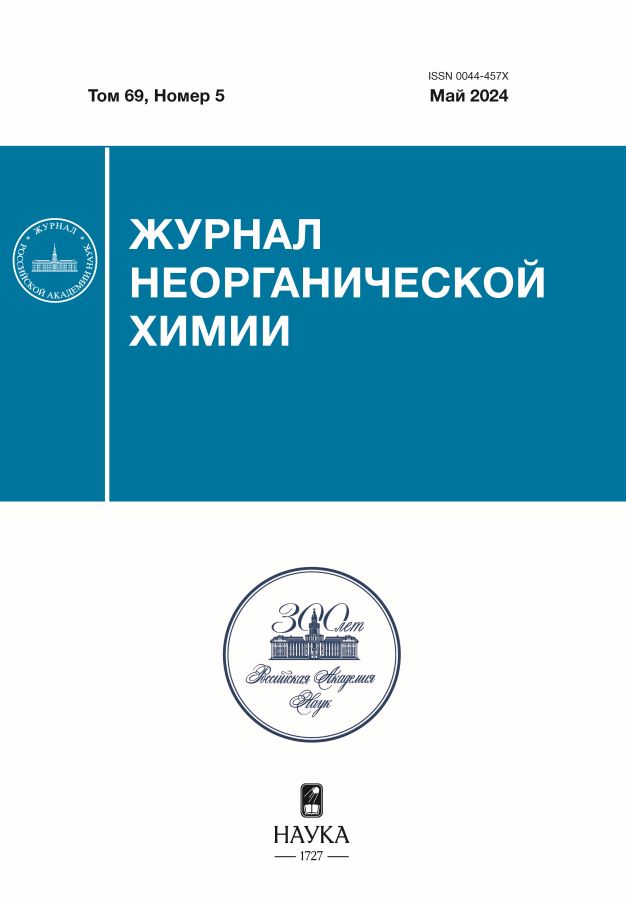Structural variability of rare-earth bromide complexes with acetylurea
- Autores: Akulinin P.V.1, Savinkina Е.V.1, Grigoriev М.S.2, Belousov Y.А.3,4
-
Afiliações:
- MIREA — Russian Technological University
- Frumkin Institute of Physical Chemistry and Electrochemistry RAS
- Lomonosov Moscow State University
- Lebedev Physical Institute RAS
- Edição: Volume 69, Nº 5 (2024)
- Páginas: 727-735
- Seção: КООРДИНАЦИОННЫЕ СОЕДИНЕНИЯ
- URL: https://rjonco.com/0044-457X/article/view/666539
- DOI: https://doi.org/10.31857/S0044457X24050102
- EDN: https://elibrary.ru/YEXFTM
- ID: 666539
Citar
Texto integral
Resumo
New coordination compounds of light rare-earth (RE) bromides with acetylurea (AsUr) were synthesized, [Y(AcUr)2(H2O)4]1.39[Y(AcUr)2(H2O)5]0.61Br6·2H2O (I), [La(AcUr)2(H2O)5]Br3 (II), [Ce(AcUr)2(H2O)5]Br3 (III), [Nd(AcUr)2(H2O)5]Br3 (IV), [Sm(AcUr)2(H2O)5]Br3 (V); elemental analysis, IR spectroscopy and X-ray diffraction were used to determine their compositions and structural features. Compound I is built of the [Y(AcUr)2(H2O)4]3+ and [Y(AcUr)2(H2O)5]3+ cations in the 2.28 : 1; they differ by the number of the inner-sphere water molecules (4 and 5 for coordination numbers 8 and 9, respectively), non-coordinated Br— ions and H2O molecules. Compounds II and III are built of the [Ln(AcUr)2(H2O)5]3+ (Ln = La, Ce) cations and outer-sphere Br— ions. The structures changes on cooling from 296 K to 100 K being isostructural at both temperatures. Compounds IV and V have the same composition, but different structures. They also have different polymorphous modifications at 100 and 296 K. Samarium, terbium and dysprosium bromide complexes of acetyl urea show photoluminescence.
Palavras-chave
Sobre autores
P. Akulinin
MIREA — Russian Technological University
Email: savinkina@mirea.ru
Lomonosov Institute of Fine Chemical Technologies
Rússia, MoscowЕ. Savinkina
MIREA — Russian Technological University
Autor responsável pela correspondência
Email: savinkina@mirea.ru
Lomonosov Institute of Fine Chemical Technologies
Rússia, MoscowМ. Grigoriev
Frumkin Institute of Physical Chemistry and Electrochemistry RAS
Email: savinkina@mirea.ru
Rússia, Moscow
Yu. Belousov
Lomonosov Moscow State University; Lebedev Physical Institute RAS
Email: savinkina@mirea.ru
Faculty of Chemistry
Rússia, Moscow; MoscowBibliografia
- Shibasaki M., Yoshikawa N. // Chem. Rev. 2002. V. 102. № 6. P. 2187. https://doi.org/10.1021/cr010297z
- Binnemans K. // Chem. Rev. 2009. V. 109. № 9. P. 4283. https://doi.org/10.1021/cr8003983
- Woodruff D.N., Winpenny R.E.P., Layfield R.A. // Chem. Rev. 2013. V. 113. № 7. P. 5110. https://doi.org/10.1021/cr400018q
- Lanthanides, tantalum, and niobium: mineralogy, geochemistry, characteristics of primary ore deposits, prospecting, processing and applications. Proceedings of a workshop in Berlin, November 1986 / Eds. Möller P., Černý P., Saupé F. Berlin, Heidelberg: Springer-Verlag, 1989. 380 p.
- Seitz M., Oliver A.G., Raymond K.N. // J. Amer. Chem. Soc. 2007. V. 129. № 36. P. 11153. https://doi.org/10.1021/ja072750f
- Cotton S.A., Raithby P.R. // Coord. Chem. Rev. 2017. V. 340. P. 220. https://doi.org/10.1016/j.ccr.2017.01.011
- Cotton S. Lanthanide and actinide chemistry. John Wiley & Sons, 2013. 288 p.
- Cotton S.A. // Chimie. 2005. V. 8. № 2. P. 129. https://doi.org/10.1016/j.crci.2004.07.002
- Kim P., Anderko A., Navrotsky A., Riman R.E. // Minerals. 2018. V. 8. № 3. P. 106. https://doi.org/10.3390/min8030106
- Gumin´ski C., Voigt H., Zeng D. // Monatsh. Chem. 2011. V. 142. P. 211. https://doi.org/10.1007/s00706-011-0457-y
- Yin X., Wang Y., Bai X., et al. // Nat. Commun. 2017. V. 8. P. 14438. https://doi.org/10.1038/ncomms14438
- Savinkina E.V., Golubev D.V., Podgornov K.V., et al. // Z. Anorg. Allgem. Chem. 2013. V. 639. № 1. P. 53. https://doi.org/10.1002/zaac.201200267
- Аликберова Л.Ю., Альбов Д.В., Бушмелева А.С. и др. // Коорд. химия. 2014. Т. 40. № 12. С. 748.
- Isbjakowa A.S., Grigoriev M.S., Golubev D.V., Savinkina E.V. // J. Mol. Struct. 2020. V. 1201. №. 127141. https://doi.org/10.1016/j.molstruc.2019.127141
- Bushmeleva A.S., Alikberova L.Y., Albov D.V. // Advancing Coordination, Bioinorganic and Applied Inorganic Chemistry. The 50th Anniversary of ICCBIC / Eds. Melník M., Segľa P., Tatarko M. Bratislava: Slovak Chemical Society, 2015. P. 27–40.
- Savinkina E.V., Akulinin P.V., Golubev D.V., Grigoriev M.S. // Polyhedron. 2021. V. 204. P. 115258. https://doi.org/10.1016/j.poly.2021.115258
- Sheldrick G.M. SADABS. Madison, Wisconsin (USA): Bruker AXS, 2008.
- Sheldrick G.M. // Acta Crystallogr. Sect. A. 2008. V. 64. № 1. P. 112. https://doi.org/10.1107/S0108767307043930
- Sheldrick G.M. // Acta Crystallogr. Sect. C. 2015. V. 714. № 1. P. 3. https://doi.org/10.1107/S2053229614024218
- Bünzli J.-C.G., Eliseeva S.V. // Lanthanide Luminescence: Photophysical, Analytical and Biological Aspects / Eds. Hänninen P., Härmä H. Berlin, Heidelberg: Springer-Verlag, 2011. P. 1.
- Kimura T., Kato Y. // J. Alloys Compd. 1998. V. 275. P. 806. https://doi.org/10.1016/S0925-8388(98)00446-0
- Kiskin M.A., Taydakov I.V., Metlin M.T. et al. // Dye. Pigment. 2022. V. 199. № 110078. https://doi.org/10.1016/j.dyepig.2021.110078
- Feng X., Li S.-H., Wang L-Y. et al. // CrystEngComm. 2012. V. 14. № 10. P. 3684. https://doi.org/10.1039/C2CE06151A
- Savinkina E.V., Golubev D.V., Grigoriev M.S., Kornilov A. // J. Mol. Struct. 2021. V. 1227. №. 5. P. 129526. https://doi.org/10.1016/j.molstruc.2020.129526
- Аликберова Л.Ю., Антоненко Т.А., Альбов Д.В. // Тонкие химические технологии. 2015. Т. 10. № 1. С. 66.
- Haddad S.F. // Acta Crystallogr. Sect. C. 1988. V. 44. № 5. P. 815. https://doi.org/10.1107/S010827018800054X
- Haddad S.F. // Acta Crystallogr. Sect. C. 1987. V. 43. № 10. P. 1882. https://doi.org/10.1107/S0108270187089753
- Корнилов А.Д., Григорьев М.С., Савинкина Е.В. // Тонкие химические технологии. 2022. Т. 17. № 2. С. 172.
- Заполоцкий Е.Н., Бабаилов С.П. // Известия АН. Сер. Химическая. 2022. Т. 71. № 10. С. 2165.
- Заполоцкий Е. Н., Бабайлов С. П. Журн. неорган. химии. 2022. T. 67. № 11. С. 1646.
Arquivos suplementares










